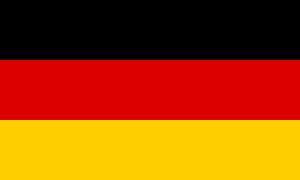
| Colors | HEX Code | RGB | CMYK |
|---|---|---|---|
| Black | #000000 | 0, 0, 0 | 0, 0, 0, 100 |
| Red | #DD0000 | 221, 0, 0 | 0, 100, 100, 13 |
| Yellow | #FFCE00 | 255, 206, 0 | 0, 19, 100, 0 |
The German flag has three equal horizontal stripes. It is a tri colored flag. The upper band is colored black. The middle stripe is colored red, and the bottom stripe is colored yellow.
Meaning of the German Flag
Black symbolizes the dignity and determination of the German people. Red represents bravery, strength, and valor. The color of gold is associated with wealth, power, and prestige.
History of the German Flag
In the 9th and 10th centuries, Germany was part of the Holy Roman Empire. Its banner featured a black eagle on a yellow shield. The Holy Roman Empire collapsed in 1806, and 16 German states united under the name of the Confederation of the Rhine, which was put under the control of France. The flag of France was the official flag of the Confederation. In 1816, Napoleon was defeated, and a German Federation was created. The Liberals took control of the country in 1848, and the black, red, and gold became the official colors of Germany. In the top left corner, there was the double-headed black eagle. In 1871, after the unification of northern German states with Prussia, the German Empire rose. A black-white-red flag was the official flag of the German Empire which then collapsed in 1918. Germany was defeated in WWI, and the black-red-gold flag was restored when the Weimar Republic replaced the German Empire. In 1933, when the Nazis took power, they reused the black-white-red flag together with the Nazi flag. In 1948, after the defeat of Germany in WWII, Germany was divided into the German Democratic Republic which was ruled by the Soviets, and the Republic of Germany which was run by the US and Great Britain. The soviet rule ended in 1990, and Germany was unified as the Federal Republic of Germany, where the black-red-gold flag became the national flag again.